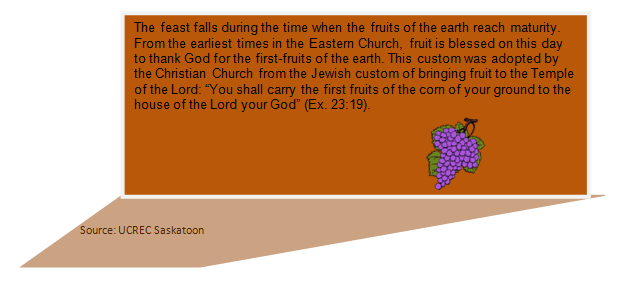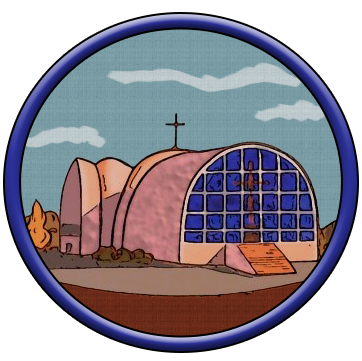The Feast of the Transfiguration (Spasa)
August 6
By the hand of Father Luke Dingman, www.lukedingman.com
The Transfiguration is one of the miracles of Jesus in the Gospels. This miracle is unique in that the miracle happens to Jesus Himself. In the Gospel accounts Jesus along with Peter, John and James go to Mount Tabor. Forty days before He was delivered to an ignominious death for our sins, our Lord revealed to three of His disciples the glory of His Divinity. On the mountain Jesus begins to shine with bright rays of light, and the prophets Elijah and Moses appear and speak to Him. Jesus is then called “Son” by a voice in the sky.
The Transfiguration is seen as a theophany, a manifestation of the Holy Trinity: of the Son in the person of Jesus; the Spirit in the bright, overshadowing cloud; and the Father in the voice from the cloud. There is a link between the Feasts of Christ’s Baptism and his Transfiguration, for both involve the activity and manifestation of the Trinity.
In Christian teachings, the Transfiguration is a pivotal moment, and the setting on the mountain is presented as the point where human nature meets God: the meeting place for the temporal and the eternal, with Jesus himself as the connecting point, acting as the bridge between heaven and earth.
For the apostles the transfiguration formed part of their training. It should have disposed them to believe in the divinity of Christ, even during His passion and death. In particular, the three favored apostles should have become sufficiently mature to remain faithful during their Master’s deepest humiliation on Olivet and Calvary.
For us the transfiguration is, and will always remain, heaven’s testimony to Christ’s divinity. All the miracles of Christ served this end, to reveal the divinity of Christ. Jesus passed His life on earth as a poor, ordinary, simple Jew. But at the transfiguration, He threw off the dark mantle of humanity and revealed Himself in full divine splendor. In spirit we gaze upon Him glorified and say: “Lord, I believe. Thou art the Christ, the Son of the living God.” Yet another truth is proclaimed in today’s mystery: that some day we too will be glorified.
What is the importance of the transfiguration to the liturgy itself? Remember, the liturgical texts not only serve to give instruction; their principal function is to signify that which actually takes place. What once happened during the night on Mount Tabor happens again every time the holy Sacrifice is offered. We may see only the simple appearances upon the altar, but with the eyes of faith we behold the glorified Christ; we see, in fact, the King of glory with His court, the saints of the Old and New Covenant. Liturgy actualizes in our very presence the sanctifying act of Christ at His transfiguration.
It is, therefore, not only Christ who becomes transfigured — He allows us to share His glory. The Holy Eucharist is the sacrament of the transfiguration, for it is “the seed of glory.” The purpose of the liturgy is the divine transfiguration of the participants.
Excerpts from With Christ Through the Year: The Liturgical Year in Word and Symbols by Rev. Bernard Strasser, O.S.B., 1947, The Bruce Publishing Company
The Icon:
Elijah and Moses stand at the top of separate mountain peaks to the left and right of Christ. Why Moses and Elijah? St. John Chrysostom gives three possible reasons: they represent the law and the prophets; they both experienced visions of God; they represent the living and the dead (Elijah, the living, because he was taken up to heaven by a chariot of fire, and Moses, the dead, because he experienced death.) Christ is the Lord of the living and the dead.
The icon shows the historical event, and through the symbolism of light and colour, shows the divine indwelling of the Holy Spirit in each person. Humanity and nature can be transfigured. The glory of God is seen in nature, in Holy Scripture, and in the personal incarnation of the Son of God.
The brilliant white figure of Christ stands within a circular mandorla on the central mountain peak. His right hand is raised in blessing; his left hand holds the scroll. His halo is inscribed with a cross. His dominant position within the circular mandorla makes him the visual and theological centre of the icon. Only Christ stands totally within the mandorla. The dark blue of the mandorla indicates the depths and mystery of God which only Christ, as God, can penetrate. The circular design of the mandorla includes Elijah and Moses in the divine glory which is why the upper section of the icon is more radiant than the lower section of the icon.
Christ is transfigured, shining, white. Three rays of light point down from Christ and touch the apostles showing the Trinitarian source of the Light. His divinity and perfect humanity are manifested. The rocks, the trees, the whole earth is filled with light. The uncreated light of the Trinity transfigures the earth.
Light from Christ’s glory on the top of Mt. Tabor is reflected from the bodies of the disoriented apostles and from the rocks. Peter, James, and John, present at the transfiguration, would later be present at the agony in the Garden of Olives. The apostles are in various positions reeling from the impact of the vision:
On the left, St. Peter, kneeling, raises his left hand towards Christ in a gesture expressing his desire to build three tents to accommodate Christ, Moses and Elijah. St. John, always in the centre, is shown as fallen, his back turned to the light. St. James, on the right, is portrayed as fleeing from the light.
Themes of the Feast:
Vision of God
Our longing to see God.
“Blessed are the pure of heart, for they shall see God” (Mt. 5:8).
“Now we see in a mirror dimly, but then face to face” (1 Cor. 13:12)
Glory of God
One way of talking about a visible manifestation of the invisible God, a way of describing an experience of the God who is holy, transcendent (above and beyond us), and yet present to us.
“The heavens are telling the glory of God; and the firmament proclaims his handiwork” (Ps 19:1)
“And the Word became flesh and dwelt among us…we have beheld his glory, glory as of the only Son from the Father” (John 1:14).
“And we all, with unveiled faces, beholding the glory of the Lord, are being changed into his likeness from one degree of glory to another; for this comes from the Lord who is the Spirit” (2Cor. 3:18).
Divine Energies
There is a distinction between the essence of God and the energies of God. The essence of God is God’s otherness and transcendence, God’s inner life and being which will always remain hidden from us. No one has ever seen the essence of God.
God’s energies are the ways in which God is present to his world, makes himself known to His creation. The energies are God Himself manifesting himself to his created beings. They are not separate “things” that God uses.

